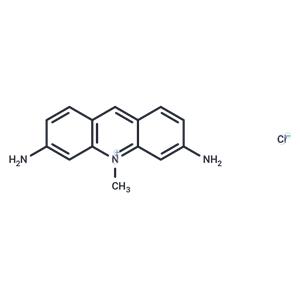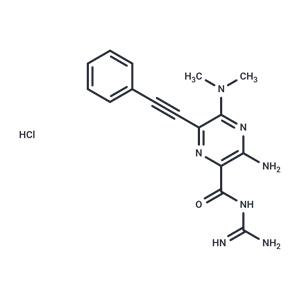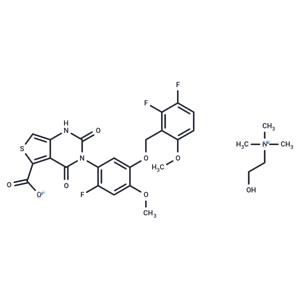
Acriflavine NEW
| Price | $34 | $47 | $105 |
| Package | 50mg | 100mg | 500mg |
| Min. Order: | |
| Supply Ability: | 10g |
| Update Time: | 2025-07-28 |
Product Details
| Product Name: Acriflavine | CAS No.: 8048-52-0 |
| Supply Ability: 10g | Release date: 2025/07/28 |
Product Introduction
Bioactivity
| Name | Acriflavine |
| Description | Acriflavine (Acriflavinium chloride 3,6-Acridinediamine mix) is a papain-like protease (PL(pro)) inhibitor, a fluorescent dye for labeling high molecular weight RNAs, has antimicrobial and anticancer activity, inhibits SARS-CoV-2 and other β-coronaviruses, and can be used for research on leukemia. be used to study leukemia. |
| Cell Research | 1. RNA marker Experimental steps: 1. Prepare solution: Dissolve Acriflavine in an appropriate solvent, such as DMSO or water, and the concentration is adjusted according to the experimental needs. 2. Label RNA: Add solution (10-100uM) to the RNA sample and incubate for a certain period of time (usually 30 minutes to 1 hour). 3. Fluorescence measurement: Use a fluorescence spectrophotometer or fluorescence microscope to detect the fluorescence signal of RNA and evaluate labeling efficiency. 2. Antibacterial experiments Experimental steps: 1. Dissolve Acriflavine: Dissolve Acriflavine in an appropriate solvent (usually in PBS or water). 2. Treat bacteria: Contact Acriflavine solution at different concentrations with the bacteria to be tested and incubate for a certain period of time. 3. Detection of inhibitory effect: Measure the antibacterial effect by bacterial growth curve or plate counting method. III. Anti-cancer research Experimental steps: 1. Dissolve Acriflavine: Dissolve Acriflavine in an appropriate solvent (such as DMSO). 2. Treat tumor cells: Add different concentrations of Acriflavine solution to cultured tumor cells and incubate for a certain period of time. 3. Cell proliferation detection: Use MTT method, cloning experiments or other cell proliferation detection methods to evaluate the anti-cancer activity of Acriflavine. IV. SARS-CoV-2 inhibition experiment Experimental steps: 1. Dissolve Acriflavine: Prepare Acriflavine solution in an appropriate solvent. 2. Contact with the virus: Add the Acriflavine solution to the virus culture system and contact with SARS-CoV-2 at different concentrations. 3. Viral inhibition detection: Viral replication level is detected by RT-PCR, virus titer experiments or immunofluorescence analysis. 5. Papain-like protease inhibition experiment: Experimental steps: 1. Prepare Acriflavine solution: Dissolve Acriflavine in an appropriate solvent and adjust the concentration. 2. Reaction with enzymes: Add Acriflavine to the reaction system of papain-like protease and incubate. 3. Measuring enzyme activity: Evaluate the inhibitory effect of Acriflavine on enzyme activity by enzyme activity detection methods, such as substrate cleavage experiments. |
| Animal Research | CML mice are treated daily with acriflavine (8 mg/kg) or PBS via intraperitoneal injection, for 10 days starting from day 7 after bone marrow transplantation [2]. |
| In vitro | A novel candidate drug, Acriflavine, exhibits significant dose-dependent inhibition of A549 cell viability at low concentrations (1, 2, 5, and 10 μM)[1]. |
| In vivo | Nude mice bearing xenografts of A549 cells were intraperitoneally injected with 2 mg/kg ACF daily for six weeks. The results indicate that treatment with ACF leads to a reduction in tumor size[1]. |
| Storage | keep away from direct sunlight,keep away from moisture | Powder: -20°C for 3 years | In solvent: -80°C for 1 year | Shipping with blue ice/Shipping at ambient temperature. |
| Solubility Information | H2O : 20 mg/mL (42.65 mM), Sonication is recommended. |
| Keywords | SARS-CoV-2 | SARSCoV | Antibacterial | Acriflavine |
| Inhibitors Related | Neomycin sulfate | Ampicillin sodium | Doxycycline (hyclate) | Methyl anthranilate | Kanamycin sulfate | Sulfamethoxazole sodium | Terbinafine hydrochloride | Hydroxychloroquine | Doxycycline | Penicillin G potassium | Dimethyl sulfoxide | Ethyl acetoacetate |
| Related Compound Libraries | Bioactive Compound Library | ReFRAME Related Library | Anti-Cancer Clinical Compound Library | Drug Repurposing Compound Library | Anti-Viral Compound Library | Inhibitor Library | Anti-Bacterial Compound Library | Bioactive Compounds Library Max | Anti-Cancer Compound Library | Anti-Infection Compound Library | Anti-Cancer Drug Library | Anti-Cancer Active Compound Library |
Company Profile Introduction
Target Molecule Corp. (TargetMol) is a global high-tech enterprise, headquartered in Boston, MA, specializing in chemical and biological research product and service to meet the research needs of global customers.
TargetMol has evolved into one of the biggest global compound library and small molecule suppliers and a customer based on 40+ countries. TargetMol offers over 80 types of compound libraries and a wide range of high-quality research chemicals including inhibitors, activator, natural compounds, peptides, inhibitory antibodies, and novel life-science kits, for laboratory and scientific use. Besides, virtual screening service is also available for customers who would like to conduct the computer-aided drug discovery.
You may like
Recommended supplier
| Product name | Price | Suppliers | Update time | |
|---|---|---|---|---|
| $0.00/25KG |
VIP1Y
|
Shaanxi Dideu New Materials Co. Ltd
|
2024-11-13 | |
| $30.00/1kg |
Shanghai Chinqesen Biotechnology Co., Ltd.
|
2023-10-30 | ||
| $0.00/100G |
VIP5Y
|
WUHAN FORTUNA CHEMICAL CO., LTD
|
2023-01-31 | |
| $1.10/1g |
VIP5Y
|
Dideu Industries Group Limited
|
2021-07-21 | |
| $87.30/1KG |
Baoji Guokang Healthchem co.,ltd
|
2021-06-08 | ||
| $0.00/1KG |
VIP6Y
|
Shaanxi Dideu Medichem Co. Ltd
|
2020-05-03 | |
| $1.00/1kg |
VIP8Y
|
Career Henan Chemical Co
|
2018-12-24 | |
| $1.00/1kg |
VIP8Y
|
Career Henan Chemical Co
|
2018-12-24 |
- Since: 2011-01-07
- Address: 36 Washington Street, Wellesley Hill, MA
INQUIRY







 United States
United States